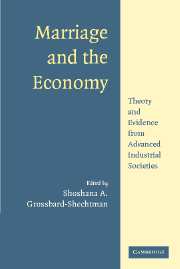Book contents
- Frontmatter
- Contents
- List of Figures
- List of Tables
- List of Contributors
- Foreword
- Acknowledgments
- Marriage and the Economy
- 1 Marriage and the Economy
- PART I THE ECONOMICS OF MARRIAGE AND DIVORCE
- PART II EFFECTS OF MARRIAGE ON INCOME USES
- PART III EFFECTS OF MARRIAGE ON TIME USES
- PART IV MARRIAGE AND THE MACROECONOMY
- 13 Married Households and Gross Household Product
- 14 Marriage, Parental Investment, and the Macroeconomy
- Index
13 - Married Households and Gross Household Product
Published online by Cambridge University Press: 07 December 2009
- Frontmatter
- Contents
- List of Figures
- List of Tables
- List of Contributors
- Foreword
- Acknowledgments
- Marriage and the Economy
- 1 Marriage and the Economy
- PART I THE ECONOMICS OF MARRIAGE AND DIVORCE
- PART II EFFECTS OF MARRIAGE ON INCOME USES
- PART III EFFECTS OF MARRIAGE ON TIME USES
- PART IV MARRIAGE AND THE MACROECONOMY
- 13 Married Households and Gross Household Product
- 14 Marriage, Parental Investment, and the Macroeconomy
- Index
Summary
The measurement of household production is an exciting new field for empirical economic research and analysis. There is growing interest in research on macroeconomic importance of the value added by households using their own unpaid labor and their own capital. Governments in many countries (such as Australia, Canada, Finland, Germany, Italy, New Zealand, and Norway) have been providing millions of dollars for their national statistical offices to collect regular data on household time use. These data then help provide estimates of Gross Household Product (GHP), the value adde d by unpaid labor and household capital (Duncan S. Ironmonger 1996a, 2001).
This chapter provides estimates of the value of GHP contributed by married households. The estimates could be called “Married Households GHP.” The chapter also provides estimates of the GHP produced by unmarried households. The GHP estimates are for Australia for the twelve months to June30, 1994, and are probably the first estimates for any country of the contribution of married households to household production. In macroeconomic terms, while married households were 63 percent of all households, they contained 74 percent of the adult population and produced 75 percent of GHP.
MARRIED AND UNMARRIED HOUSEHOLDS DEFINED
The criteria for distinguishing married households from unmarried households need to be determined before the household production accounts can be prepared. What definition of marriage should be adopted – legal or de facto? In keeping with the broad definition of marriage adopted by this book, married households include all households containing adult couples who state they are married, either legally or de facto.
- Type
- Chapter
- Information
- Marriage and the EconomyTheory and Evidence from Advanced Industrial Societies, pp. 293 - 317Publisher: Cambridge University PressPrint publication year: 2003



